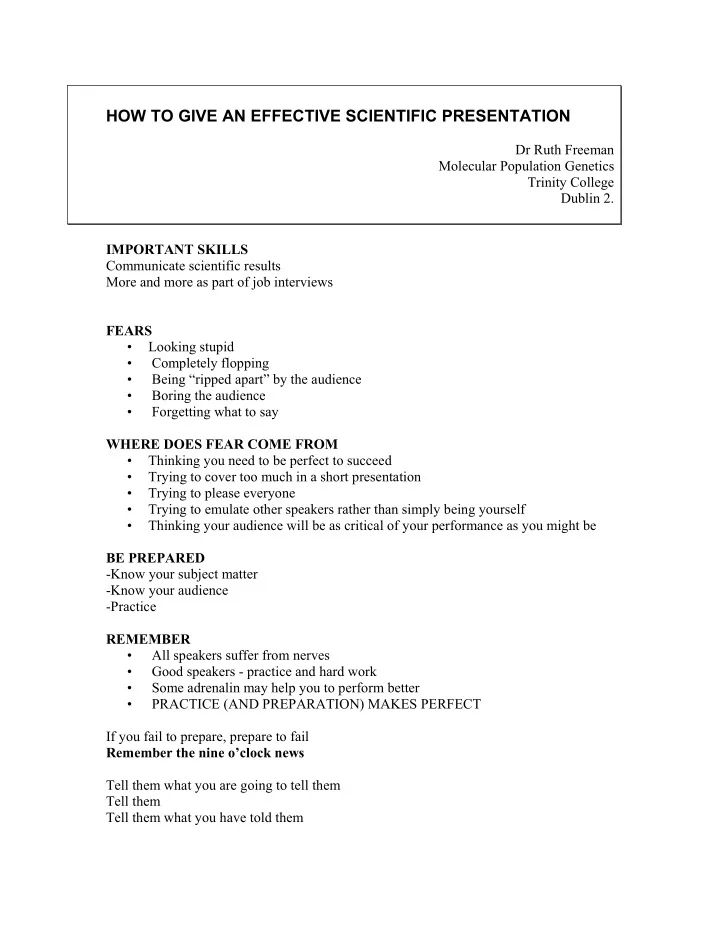

HOW TO GIVE AN EFFECTIVE SCIENTIFIC PRESENTATION Dr Ruth Freeman Molecular Population Genetics Trinity College Dublin 2. IMPORTANT SKILLS Communicate scientific results More and more as part of job interviews FEARS • Looking stupid • Completely flopping • Being “ripped apart” by the audience • Boring the audience • Forgetting what to say WHERE DOES FEAR COME FROM • Thinking you need to be perfect to succeed • Trying to cover too much in a short presentation • Trying to please everyone • Trying to emulate other speakers rather than simply being yourself • Thinking your audience will be as critical of your performance as you might be BE PREPARED -Know your subject matter -Know your audience -Practice REMEMBER • All speakers suffer from nerves • Good speakers - practice and hard work • Some adrenalin may help you to perform better • PRACTICE (AND PREPARATION) MAKES PERFECT If you fail to prepare, prepare to fail Remember the nine o’clock news Tell them what you are going to tell them Tell them Tell them what you have told them
SIX THINGS TO BEAR IN MIND • The aim of the presentation the Why • The content the What • The audience the Who • The learning/teaching method the How • The environment the When and Where WHAT ARE YOUR GOALS? NOT: - to show an encyclopedic knowledge - to demonstrate statistical and methodological skills ARE: - Communication - Communicating the right impression WHAT DO YOU WANT TO SAY? “Take what you know and make it sound like it is all you need to know.” • Only present a subset of your work • Excess detail: - detracts from your presentation - may invite awkward questions - makes the audience switch off Think about “Listener Energy” STRUCTURE • Opening • Objective Explained • 3 - 5 key points • Bridge between points • Summary • Question time • Close KNOW YOUR AUDIENCE • Who are the participants? Level? Background? Mixed? • What do they already know about the topic? (JARGON) • Will they really be interested? • How fast will they absorb the information?
• What are their prejudices, attitudes, beliefs? • What do they want from you? WHAT IS THE BEST WAY TO GET YOUR MESSAGE ACROSS? • Hook • Raise meaningful questions • Use antagonists • Give some sensible answers • Humour? • REPEAT YOUR MESSAGE MAKE YOUR INFORMATION ACCESSIBLE • Statistics/Numbers • Use visual aids – next week • Handouts – at the end • Headlines – informative • Write to your time limit – How? • Practice out loud BEFORE YOU START • Be ready/on time • Bring anything you might need • Check your equipment • Create a good first impressions-don’t hide • Take a few deep breaths and REMEMBER... THE AUDIENCE WANTS YOU TO SUCCEED!! BEGINNNING • Check the time - know when you have to end • Introduce yourself • Don’t apologise • Respect audience – coffee break/last talk • Opening sentences ready • Let people know what to expect • What are the rules? WHERE TO LOOK • Face the audience – do not speak to your notes, your visual aids, or imaginary people. • Check each slide • Pause every now and then • Maintain eye contact • Gauge understanding – one thought, one face
SPEAKING • Some people are naturally quiet - project voice • too fast • monotone, “ums” and “ahs” • simple language where possible • Positive language, no double negatives • Try not to read word for word from the overheads • But DO read or refer to your overheads DO NOT • Cling to furniture • Clasp your hands in front of you or behind you • Cross your arms • Put your hands in your pockets • Play with pointer, coins, keys, hair, jewellery, clothes • Sway DO • Have your hands relaxed at your side • Put down anything you are not using • Use your hands for emphasis MAXIMISE UNDERSTANDING • Do not assume that your audience have absorbed everything from previous slides. • Don’t go off on a tangent or write new information on an overhead • Do not speak on one topic while expecting people to read something else. FINISHING UP • Watch the time • End clearly - prepare closing sentences? “So..em...that’s all” QUESTIONS • Notify in advance • Anticipate questions and criticisms • Listen to the whole question • Repeat a question to the audience • Don’t be afraid to pause • Accept a good point or critique • Hostile questions • It is OK not to know the answer –find out • Peripheral detail • Keep answers brief • Additional information
WHAT IF SOMETHING GOES VERY WRONG? • Stay calm • Practice means you know your material • Think back to what you want to say • Be prepared PRACTICE, PRACTICE, PRACTICE (tape/video?) RECAP • Get the audience interested • Keep structure and language simple • Use appropriate visual aids • Speak clearly to the audience • Stick to your time limit • Stay calm • PRACTICE REFERENCES “Giving Professional Presentations in the Behavioural Sciences and Related Fields: a practical guide for the Novice, the Nervous and the Nonchalant.” Michael J. Platow PSYCHOLOGY PRESS “Scientists must speak: bringing presentations to life” D. Eric Walters and Gale Clemenson Walters ROUTLEDGE STUDY GUIDES “Presentation Skills: the essential guide for students” Patsy McCarthy & Caroline Hatcher SAGE PUBLICATIONS How to Give a Bad Talk, David A. Patterson, University of California-Berkeley Eric Clarke, Royal College of Surgeons in Ireland.
Recommend
More recommend